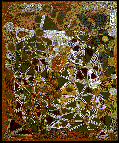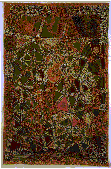|
Australian Rugs
Cultural appropriation has become commonplace in western art.
However, as western society becomes more aware of the rights
of indigenous groups some work has been done to compensate
certain indigenous groups. The aboriginal groups of Australia
have sought compensation for illegal use of their traditional
designs with a fair degree of success. Winning victories in
one case involving traditional "dream poles" (Yumbulul
v. Reserve Bank of Australia), and another involving Aboriginal
design being used on rugs imported by a non-Aboriginal man(
Milpurrurru v. Indofurn Pty. Ltd.) the indigenous groups have
brought public attention to their plight. The legal case involving
rug design is indicative of some of the problems still in
existence with the intellectual property rights of indigenous
peoples.

Tim Payunka, Kangaroo and Shield People Dreaming at Lake
McKay

Offending rug design, Indofurn Pty. Ltd. Kangaroo and
Shield People
As the rug case was tried it became clear that the idea of
monetary compensation was not enough for the Aboriginal people
infringed upon.
One artist, Banduk Marika is quoted as saying, "It is
nice to receive a bit of compensation, or whatever, but there
is a backbone of culture here and only the aboriginal person
knows the backbone." The artists in this case were able
to stop inappropriate use of traditional design. More importantly
the artists were able to demonstrate to the court that appropriation
was harmful to them culturally and could have consequences
beyond monetary damage. The court briefing states:
The reproduction of paintings which depict dreaming stories
and designs of cultural significance has been a matter of
great concern to the Aboriginal community. Pirating of Aboriginal
designs and paintings for commercial use without the consent
of the artist or the traditional owners was common for a
long time. The recognition of the sacred and religious significance
of these paintings, and the restrictions which Aboriginal
law and culture imposes on their reproduction is only now
being understood by the white community.
Judge J. Von Doussa
As positive as this judgment was, Aboriginal designs are
still being used to make rugs. The defendant no longer imports
rugs of this nature, but a simple internet search reveals
that manufacturers the world over are making rugs citing aboriginal
design, but not specific artists. The works below illustrate
designs listed under the heading "Aboriginal rugs."
 
It should be noted that many rug dealers also claim to be
dealing authentic Aboriginal designs. These rug dealers make
no such claim. This case gives some idea of the expansive
and pervasive nature that many of these appropriations/ exploitations
acquire. The judgments in this case advanced the cause of
Aboriginal artists into the public sphere. Yet, indigenous
intellectual property theft has not been completely eliminated.
[Return to Top]
|

